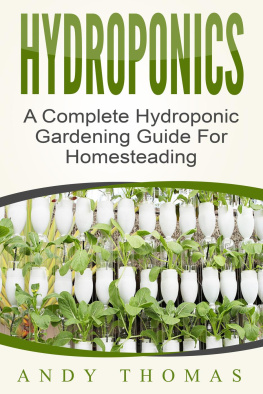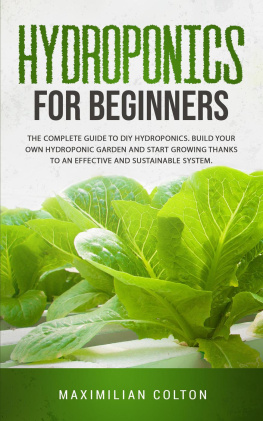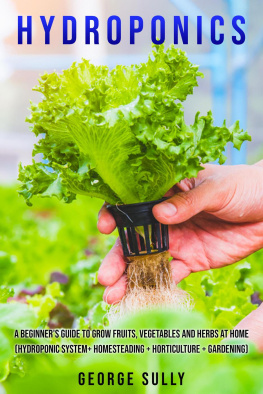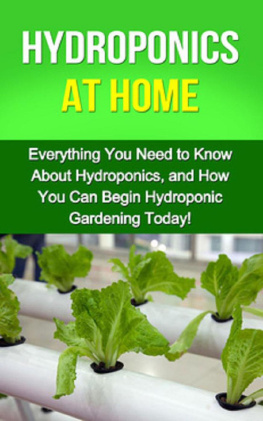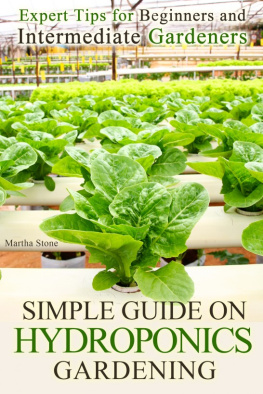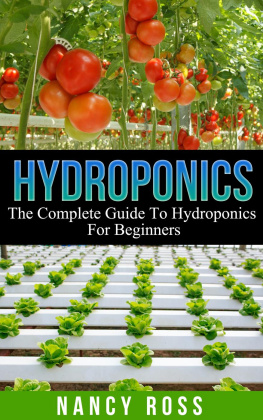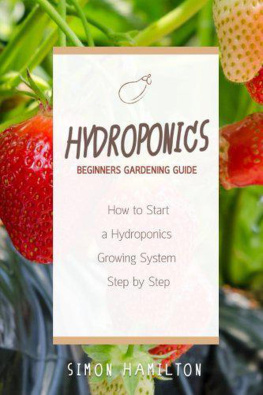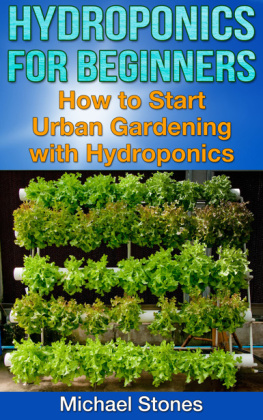Hydroponics: A Step-by-Step
Hydroponic Gardening Guide
While every precaution has been taken in the preparation of this book, the publisher assumes no responsibility for errors or omissions, or for damages resulting from the use of the information contained herein.
HYDROPONICS: A COMPLETE HYDROPONIC GARDENING GUIDE FOR HOMESTEADING
First edition. March 19, 2017.
Copyright 2017 Andy Thomas.
Written by Andy Thomas.
10 9 8 7 6 5 4 3 2 1
Introduction
Chapter 1: About Hydroponic Gardening
Why only water? Is soil a bad thing?
What exactly do plants need to grow?
What type of crops can you grow?
Is hydroponic gardening right for you?
Chapter 2: Planning Your New Garden
What is a hydro system?
The Wick System
The Lettuce Raft
Ebb and Flow
Drip Irrigation System
Nutrient Film Technique
Which system is best for you?
Chapter 3: Building Your Hydro System
What is a growing medium?
What about air flow?
How much light do I need?
Constructing the Wick System
Wick System Practice Project
Constructing a Lettuce Raft
Lettuce Raft Practice Project
Constructing an Ebb and Flow
Ebb and Flow Practice Project
Constructing a Drip Irrigation System
Drip Irrigation Practice Project
Constructing an NFT System
NFT System Practice Project
Chapter 4: Plastic, Poison, & Pollution
#1 Polyethylene Terephthalate
#2 High-Density Polyethylene
#3 Polyvinyl Chloride
#4 Low-Density Polyethylene
#5 Polypropylene
#6 Polystyrene
#7 Varied & Other
Chapter 5: Crops for Hydroponic Gardens
Herbs
Fruits
Greens
Root Crops
Vining Plants
Chapter 6: Hydroponic Nutrients
What type of nutrients do plants need?
What are macro nutrients to plants?
How do I read the NPK ratio?
What are micro nutrients to plants?
How can I buy hydroponic nutrients?
What about the pH of my water?
Is there aftercare I should do?
Conclusion
Introduction
H ydroponic gardening is a fairly modern system of growing crops that involves forgoing soil altogether, instead allowing plants direct access to any water or nutrients they may need. This allows them to grow in a clean environment at a much faster rate than normal. Although the practice has faded in and out of popularity over the years, interest in it has revived as concerns over soil pollution and strict gardening laws have increased, and you may find yourself wanting to try it out.
Well be discussing exactly what hydroponic gardening is, the basics you need to know about starting your own garden, and what you can expect from getting started. In later chapters, well be taking a deeper look at the techniques and safety precautions behind building each type of garden so that you can begin growing whichever crops youre most interested in.
This book should provide you enough of an introduction to build one of several basic hydroponic gardens with a crop of your choice, as well as the confidence to research more advanced construction methods, supplies, and techniques upon completing it.
Chapter 1: About Hydroponic Gardening
B efore we jump into guiding you through your first garden, we want to present what exactly hydroponic gardening is for those who may not be aware. The introduction touched on it being the act of growing crops without soil, but theres more science behind it all and many different methods of accomplishing this.
As any gardeners out there know from experience, you cant just flood most plants with water and expect them to grow there has to be a very specific system set in place that allows a reasonable amount of water to directly access the roots. Hydroponics (which breaks down into hydros (water) and ponos (work)) is the art behind that.
Why only water? Is soil a bad thing?
S oil is the natural way most plants grow, and it isnt necessarily a bad thing. However, you may find that hydroponic gardening is safer and more efficient than gardening in soil. Soil alone presents and invites pests, diseases, and weeds to infiltrate your garden and crops unless very carefully managed.
Those who prefer hydroponic to traditional gardening may also be concerned about where that soil has been, especially if the condition of their local soil forces them to purchase it elsewhere: were pesticides used in it? Is it from a foreign country? Was it polluted in some way beforehand? You can have full control over what your crops come in contact with when using a hydro system.
Also, hydroponic gardening does require more than just water. There are quite a few things plants need to thrive and grow their best, much of which is stripped away when soil is removed. Despite supplementing these things, you can still save a great deal of space by forgoing soil and building compressed hydro systems in place of potted plants or traditional gardens, which is a plus for those with a minimal amount of space to work with.
What exactly do plants need to grow?
W ell be going into more depth about specific nutrients later. The basics science, which youll be using to craft your garden, is that plants need light, oxygen, carbon dioxide, water, and varying types of nutrients. Water has a number of different functions in the plant system from keeping it moisturized to transporting nutrients. Just as plants in the wild need sunlight, crops in a hydro system need light to carry out photosynthesis, a necessary process that allows the plant to take in any nutrients it receives. This process also causes the plant to release oxygen created after taking in carbon dioxide from the air. Hydroponic gardening is designed to provide these things, combined with nutrients, in the dosage most appropriate for the crop being grown.
What type of crops can you grow?
M ost flowers, herbs, vegetables, and some fruits can be grown through hydro systems. Mushrooms and other fungi can generally not be grown through them. Well go over some specific crops and plant types and how they grow best in later chapters.
Is hydroponic gardening right for you?
H ydroponic gardening isnt perfect. By that we mean its both not a perfect science and not a perfect choice for everyone. You are going to have frustrating times where you do everything right and something just doesnt grow or flower. There is also a large initial investment of time and money needed to really get your garden put together: planning it, constructing it, purchasing the crops, purchasing the nutrients, and managing it daily until / unless youve managed to automate it. You can shove some seeds in the earth and pray for the best in a traditional garden, but the plants in your hydro system are only alive because youve specifically given them the means to be. A full-fledged hydroponic garden is an honest commitment you need to think about before jumping into.
That said, you may find that its an incredibly worthwhile commitment. If youre a gardener looking for something new, or have never been able to get into traditional gardening, or are even a bit curious, then read on. Try some of our smaller sample projects along the way to see if its for you.
Chapter 2: Planning Your New Garden
T he first step to creating a hydroponic garden is understanding your own needs and limitations, the kind of crops you want to get out of your garden, the types of systems hydroponic gardening lends itself to, and how these can all line up. Well be going over that in this chapter. You should have an idea of what hydro system you want or need to implement for your first garden by chapter three.
What is a hydro system?
Next page
